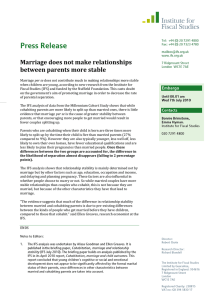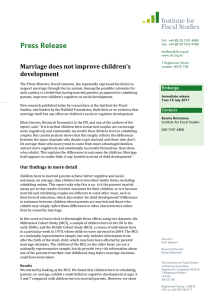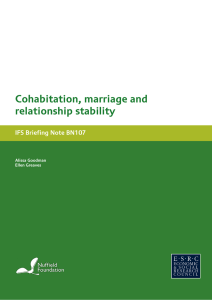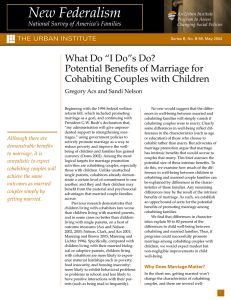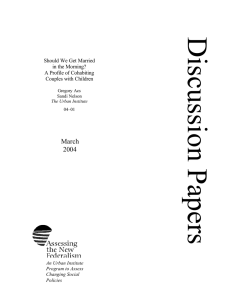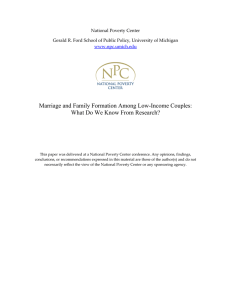Press Release Encouraging parents to marry unlikely to
advertisement
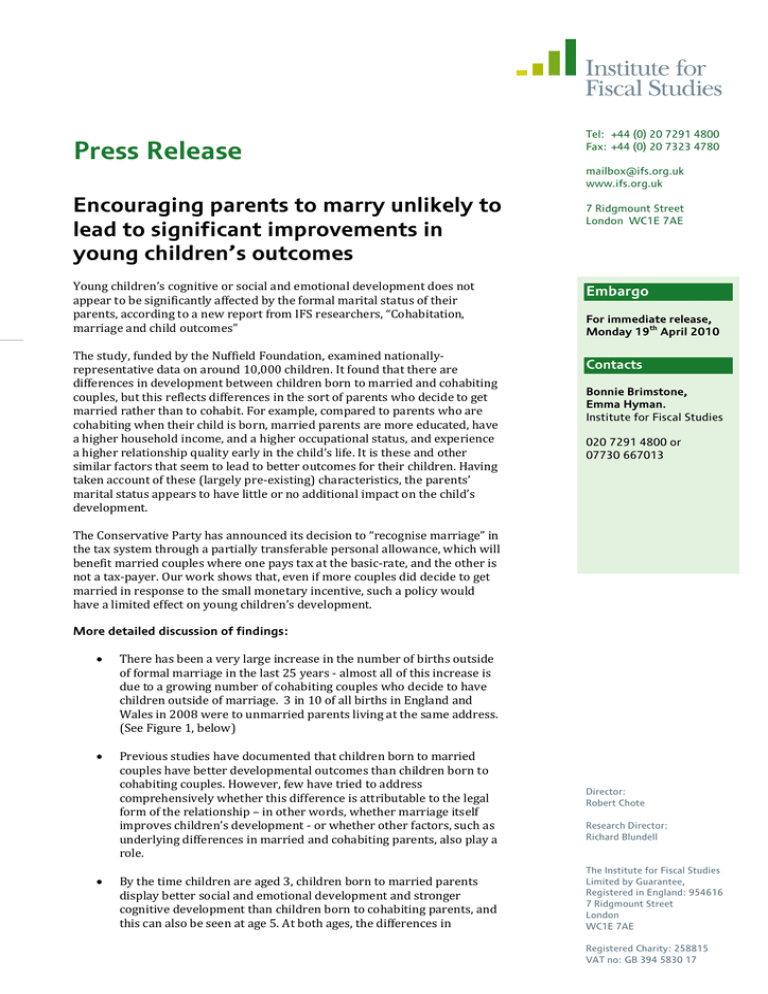
Press Release Tel: +44 (0) 20 7291 4800 Fax: +44 (0) 20 7323 4780 mailbox@ifs.org.uk www.ifs.org.uk Encouraging parents to marry unlikely to lead to significant improvements in young children’s outcomes Young children’s cognitive or social and emotional development does not appear to be significantly affected by the formal marital status of their parents, according to a new report from IFS researchers, “Cohabitation, marriage and child outcomes” The study, funded by the Nuffield Foundation, examined nationallyrepresentative data on around 10,000 children. It found that there are differences in development between children born to married and cohabiting couples, but this reflects differences in the sort of parents who decide to get married rather than to cohabit. For example, compared to parents who are cohabiting when their child is born, married parents are more educated, have a higher household income, and a higher occupational status, and experience a higher relationship quality early in the child’s life. It is these and other similar factors that seem to lead to better outcomes for their children. Having taken account of these (largely pre-existing) characteristics, the parents’ marital status appears to have little or no additional impact on the child’s development. 7 Ridgmount Street London WC1E 7AE Embargo For immediate release, Monday 19th April 2010 Contacts Bonnie Brimstone, Emma Hyman. Institute for Fiscal Studies 020 7291 4800 or 07730 667013 The Conservative Party has announced its decision to “recognise marriage” in the tax system through a partially transferable personal allowance, which will benefit married couples where one pays tax at the basic-rate, and the other is not a tax-payer. Our work shows that, even if more couples did decide to get married in response to the small monetary incentive, such a policy would have a limited effect on young children’s development. More detailed discussion of findings: • There has been a very large increase in the number of births outside of formal marriage in the last 25 years - almost all of this increase is due to a growing number of cohabiting couples who decide to have children outside of marriage. 3 in 10 of all births in England and Wales in 2008 were to unmarried parents living at the same address. (See Figure 1, below) • Previous studies have documented that children born to married couples have better developmental outcomes than children born to cohabiting couples. However, few have tried to address comprehensively whether this difference is attributable to the legal form of the relationship – in other words, whether marriage itself improves children’s development - or whether other factors, such as underlying differences in married and cohabiting parents, also play a role. • By the time children are aged 3, children born to married parents display better social and emotional development and stronger cognitive development than children born to cohabiting parents, and this can also be seen at age 5. At both ages, the differences in Director: Robert Chote Research Director: Richard Blundell The Institute for Fiscal Studies Limited by Guarantee, Registered in England: 954616 7 Ridgmount Street London WC1E 7AE Registered Charity: 258815 VAT no: GB 394 5830 17 children’s social and emotional development are much larger than the differences in their cognitive development. • The gap in cognitive development at ages 3 and 5 between children born to cohabiting parents and those born to married parents is greatly reduced, and is no longer statistically significant, after accounting for differences in parents’ education, occupation, income and housing tenure. The report argues that these characteristics of the parents are unlikely themselves to be affected by whether the parents are married or cohabiting, but instead largely reflect differences in the kinds of people getting married. • The gap in social and emotional development at ages 3 and 5 between children born to cohabiting parents and those born to married parents is reduced by more than half, but remains statistically significant, once differences in parental education and socio-economic status are accounted for. Once the likelihood of a pregnancy being unplanned and the relationship quality when the child is 9 months old are also accounted for, the gap in social and emotional development between the children of married and cohabiting parents becomes yet smaller, and is now statistically insignificant. • The report’s findings cannot provide a definitive estimate of the causal impact (or lack of impact) of marriage. A robust assessment of this is probably impossible, but the report improves on previous work in the area by accounting for differences in the characteristics of parents that reflect differences in the sort of couples who decide to enter into marriage. By doing this, the report aims to provide a more accurate estimate of the true impact of marriage on children’s development. • The report concludes that encouraging parents to marry is unlikely to lead to significant improvements in young children’s outcomes, but there is room for other interpretations. For example, for the report’s findings to be consistent with marriage having a significant positive causal effect on children’s development, it would have to be the case that marriage leads to large improvements in parents’ characteristics including their education, income, or relationship quality by the time the child is 9 months old. This seems unlikely in the case of parental education, occupation and income. It is more debatable whether relationship quality is greatly affected by marriage in the early years of a relationship, or instead whether relationship quality determines whether people get married, or both. Future work is planned by the research team to address these issues in more detail. The Institute for Fiscal Studies Limited by Guarantee, Registered in England: 954616 7 Ridgmount Street London WC1E 7AE Figure 1. Outside-marriage live births (rate per 1,000 live births), 1845–2008 450 Rate per 1,000 live births 400 350 300 250 200 150 100 50 2005 1995 1985 1975 1965 1955 1945 1935 1925 1915 1905 1895 1885 1875 1865 1855 1845 0 All outside-marriage live births Cohabitants (jointly registered at same address) Lone parents (sole registration, or jointly registered at different addresses) Sources: Office for National Statistics ENDS Notes to Editors: 1. The report “Cohabitation, marriage and child outcomes” has been funded by the Nuffield Foundation, and is published today: http://www.ifs.org.uk/comms/comm114.pdf 2. The Nuffield Foundation funds research and innovation in education and social policy and also works to build capacity in education, science and social science research. The Foundation has funded this project, but the views expressed are those of the authors and not necessarily those of the Foundation. For more information contact Frances Bright, Communications Manager on 020 7681 9586 or fbright@nuffieldfoundation.org. 3. IFS press release on Conservatives’ plans to recognise one third of marriages in the tax system. Link to http://www.ifs.org.uk/publications/4811 4. This study is based on the Millennium Cohort Study (MCS), a longitudinal study of new births across the UK around the year 2000, with follow-ups when the child was 9 months old, 3 years old and 5 years old. For our analysis, we use a sample of around 10,000 of these children, whose biological parents were married or cohabiting at the time of their birth, and for whom we have developmental measures at ages 3 and 5. The Institute for Fiscal Studies Limited by Guarantee, Registered in England: 954616 7 Ridgmount Street London WC1E 7AE
